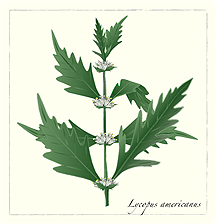Description: This native perennial plant is about 1-2' tall, sometimes branching sparingly near the base. The green or reddish central stem is four-angled and ridged; it may be hairless or slightly pubescent. This plant has a tendency to sprawl in the absence of supportive vegetation. The opposite leaves are sessile or have short petioles, and somewhat widely spaced along the stem. They are up to 3" long and 3⁄4" across, and usually lanceolate or ovate-lanceolate in overall shape. The lower leaves are lobed or pinnatifid toward the base, while the upper leaves are coarsely dentate all along their margins. The foliage is hairless, except for a few hairs along the central vein on the lower leaf surface. Whorls of white flowers occur  where the upper pairs of leaves join the stem. Each flower is about 1/6" long, and has a tubular corolla with 4 spreading lobes. There are two stamens with brown anthers that are exerted outside the corolla. The green calyx is divided into 5 triangular teeth that are more than twice as long as they are across at the base. The corolla is only a little longer than the teeth of the calyx. The blooming period is from mid-summer to early fall, and lasts about 1-2 months. Neither the foliage nor the flowers have any noticeable scent. The flowers develop into nutlets that are shorter than the calyx. These nutlets are broad and flat at the top, becoming rounded and more narrow along 3 angles toward the bottom. They have a smooth surface. There is a taproot and abundant production of rhizomes, the latter facilitating the vegetative spread of this plant.
where the upper pairs of leaves join the stem. Each flower is about 1/6" long, and has a tubular corolla with 4 spreading lobes. There are two stamens with brown anthers that are exerted outside the corolla. The green calyx is divided into 5 triangular teeth that are more than twice as long as they are across at the base. The corolla is only a little longer than the teeth of the calyx. The blooming period is from mid-summer to early fall, and lasts about 1-2 months. Neither the foliage nor the flowers have any noticeable scent. The flowers develop into nutlets that are shorter than the calyx. These nutlets are broad and flat at the top, becoming rounded and more narrow along 3 angles toward the bottom. They have a smooth surface. There is a taproot and abundant production of rhizomes, the latter facilitating the vegetative spread of this plant.
Cultivation: The preference is wet conditions and full sunlight; moist soil and partial sunlight are also tolerated. This plant normally grows in flood-prone areas with rich organic soil.
Range & Habitat: American Bugleweed is a fairly common plant that occurs in all counties of Illinois. Habitats include the sloughs of moist black soil prairies; floodplain woodlands and soggy thickets; marshes, fens, and borders of lakes and ponds; and ditches along railroads and roadsides. This is primarily a wetland plant that occurs in areas of prairie that are prone to standing water, which reduces competition from other plants. It is easy to overlook.
Faunal Associations: Primarily flies and wasps visit the flowers for nectar; some of the flies also feed on the pollen. Less common flower visitors include bees, small butterflies, skippers, and beetles. The caterpillars of Sphinx eremitus (Hermit Sphinx) feed on the foliage of this and other bugleweeds (as well as other members of the Mint family). Bugleweeds have bitter leaves and are not often eaten by mammalian herbivores.
Comments: American Bugleweed is a fairly typical member of the Mint family; it isn't particularly showy. There are several Lycopus spp. in Illinois, and they are often hard to tell apart. However, American Bugleweed is easy to identify in the field because the lower leaves have a few lobes that are deep and narrow toward the stem, as the lower photograph reveals. Other bugleweeds usually have leaves with wedge-shaped bottoms that are coarsely dentate along the entire length of their margins. If any lobes are present, they are more shallow and wide. Another name for American Bugleweed is Common Water Horehound.